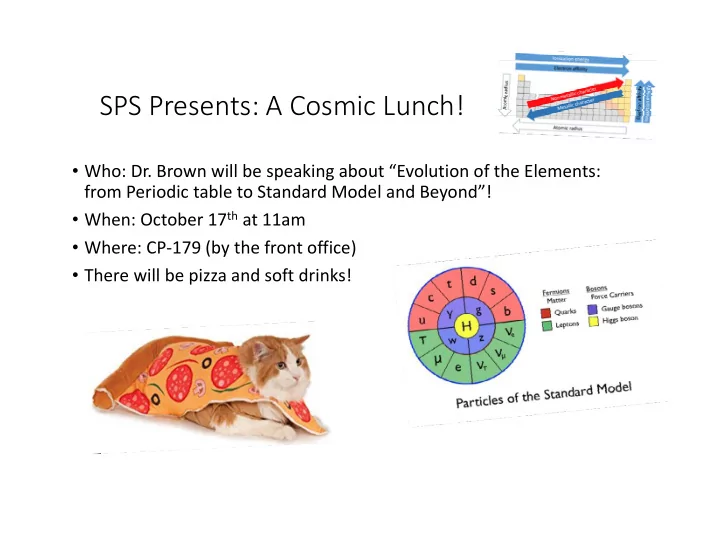

SPS Presents: A Cosmic Lunch! • Who: Dr. Brown will be speaking about “Evolution of the Elements: from Periodic table to Standard Model and Beyond”! • When: October 17 th at 11am • Where: CP ‐ 179 (by the front office) • There will be pizza and soft drinks!
Resistors in series and parallel
Why so similar, but yet so opposite? The formula for capacitors and resistors in parallel and series are oppositely switched: Resistors Capacitors 1 1 1 1 In series R R R R eff 1 2 N C C C C eff 1 2 N 1 1 1 1 In parallel C C C C eff 1 2 N R R R R eff 1 2 N V Q R C I V The formula will looks the same if we use conductance G=I / V instead of R.
Connecting Resistors in Series R N R 2 R 3 I N R 1 I 3 I 1 I 2 V 1 V N V 2 V 3 = R R R R R eff 1 2 3 N R I I I I I 1 2 3 N V V V V V V 1 2 3 N 2. Potential difference across 1. Current through each each individual resistor should individual resistor is the same: be different (unless they have (why?) the same resistance). I I I I I 1 2 3 N V V V V V 1 2 3 N R R R R R 1 2 3 N
Connecting Resistors in Parallel 1 1 1 1 1 R 1 I 1 R R R R R eff 1 2 3 N I I I I I V 1 1 2 3 N R 2 V V V V V I 2 1 2 3 N V 2 1. Potential difference across R 3 I R = I 3 each individual resistor is the same: (why?) V 3 V V V V V V 1 2 3 N I R I R I R I R 1 1 2 2 3 3 N N R N 2. Current through each I N individual resistor should be V N different (unless they have the same resistance).
Voltage Divider R N R 2 R 3 R 1 I I I I V 2 V 3 V 1 V N V Current through each individual resistor is the same V V V V Series resistors divide 1 2 N R R R R and share the voltage 1 2 N eff “proportionally”. R 1 or V V (Larger R get the 1 R R R bigger share) 1 2 N and similar for other resistors
Class 23 Electromotive force and internal resistance
Electromotive Force and Internal Resistance Electromotive force (emf ) is the A real battery work done by a battery in moving a r unit charge from one terminal to the other. It equals to the maximum possible voltage the battery can provide between its terminal. You can think it like the voltage of an ideal battery with no internal resistance. When connected externally: A real battery I R r r R V IR R R r I Load R Voltage across the load resistance R will drop if more current is drawn from the battery (by making R smaller). V R
Kirchhoff’s Rules
About Kirchhoff’s Rules 1.There are two Kirchhoff rules – Kirchhoff’s current rule (junction rule) and Kirchhoff’s voltage rule (loop rule). 2.More complex circuits cannot be broken down into parallel and series units. The two Kirchhoff’s rules allow us to solve for any circuits, no matter how complex it is (at least theoretically).
Kirchhoff’s Current Rule (Junction Rule) Kirchhoff’s current rule is a result of conservation of charges: At any junction, the sum of currents must equal zero. I 0 junction Junction formed by twisting many wires together.
Kirchhoff’s Voltage Rule Kirchhoff’s voltage rule is a result of conservation of energy: The sum of the potential differences across all elements around any closed circuit loop must be zero. V 0 closed loop Conservation of energy: Work done by battery = Energy stored in conservative elements (e.g. capacitors) + Energy dissipated by resistive elements (e.g. resistors)
Kirchhoff’s Voltage Rule – sign convention Use only currents as unknown variables. V can always be written in 1. terms of currents or derivatives or integrals of currents. 2. Assign current direction to every path in a circuit. Apply Kirchhoff’s current rule as much as you can to reduced the number of unknown variables. 3. Across every component in the circuit determine which end has a higher potential (mark it with a + sign) and which end has a lower potential (mark it with a - sign). This will depend on the current direction you assume in step 2. 4. Pick up a loop and travel around it either clockwise or anticlockwise. If you travel from – to + across a component, then V across the component is positive. If you travel from + to – across a component, then V across the component is negative. You can reverse this convention as long as you do it consistently for the whole loop. 5. If you get a negative current, that means the current direction you assume in step 2 is wrong and you should reverse that direction.
Recommend
More recommend